This document provides lecture notes on compiler design. It discusses the structure of a compiler including phases like lexical analysis, syntax analysis, intermediate code generation, code optimization, code generation, table management and error handling. It also discusses different types of translators like compilers, interpreters and preprocessors. Finally, it discusses the evolution of programming languages, classification of languages and applications of compiler technology.


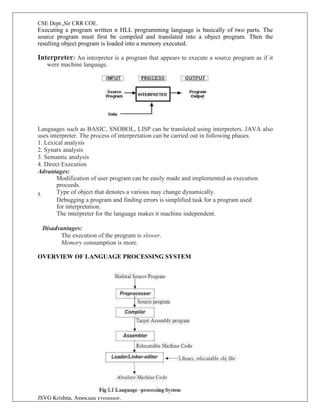

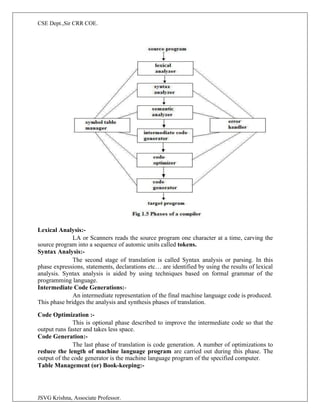

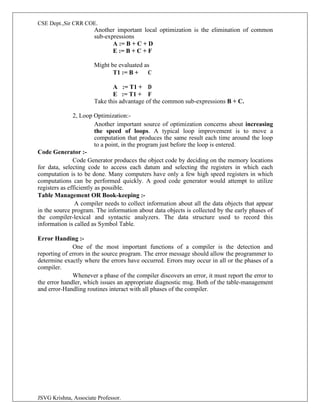



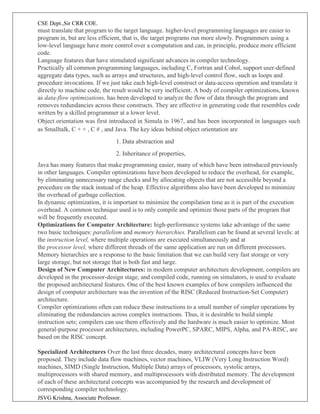


![CSE Dept.,Sir CRR COE.
JSVG Krishna, Associate Professor.
dynamic policies: macro expansion in the C preprocessor and method resolution in object-oriented
programming.
Declarations and Definitions
Declarations tell us about the types of things, while definitions tell us about their values. Thus, i n t i is a
declaration of i, while i = 1 is a definition of i.
The difference is more significant when we deal with methods or other procedures. In C + + , a method
is declared in a class definition, by giving the types of the arguments and result of the method (often
called the signature for the method. The method is then defined, i.e., the code for executing the method
is given, in another place. Similarly, it is common to define a C function in one file and declare it in
other files where the function is used.
Parameter Passing Mechanisms
In this section, we shall consider how the actual parameters (the parameters used in the call of a
procedure) are associated with the formal parameters (those used in the procedure definition). Which
mechanism is used determines how the calling-sequence code treats parameters. The great majority of
languages use either "call-by-value," or "call-by-reference," or both.
Call - by - Value
In call-by-value, the actual parameter is evaluated (if it is an expression) or copied (if it is a variable).
The value is placed in the location belonging to the corresponding formal parameter of the called
procedure. This method is used in C and Java, and is a common option in C + + , as well as in most
other languages. Call-by-value has the effect that all computation involving the formal parameters done
by the called procedure is local to that procedure, and the actual parameters themselves cannot be
changed.
Note, however, that in C we can pass a pointer to a variable to allow that variable to be changed by the
callee. Likewise, array names passed as param eters in C, C + + , or Java give the called procedure what
is in effect a pointer or reference to the array itself. Thus, if a is the name of an array of the calling
procedure, and it is passed by value to corresponding formal parameter x, then an assignment such as
x [ i ] = 2 really changes the array element a[2]. The reason is that, although x gets a copy of the value
of a, that value is really a pointer to the beginning of the area of the store where the array named a is
located.
Similarly, in Java, many variables are really references, or pointers, to the things they stand for. This
observation applies to arrays, strings, and objects of all classes. Even though Java uses call-by-value
exclusively, whenever we pass the name of an object to a called procedure, the value received by that
procedure is in effect a pointer to the object. Thus, the called procedure is able to affect the value of the
object itself.
Call - by - Reference
In call-by-reference, the address of the actual parameter is passed to the callee as the value of the
corresponding formal parameter. Uses of the formal parameter in the code of the callee are implemented
by following this pointer to the location indicated by the caller. Changes to the formal parameter thus
appear as changes to the actual parameter.](https://image.slidesharecdn.com/31compilerdesign-240226140600-10d4dc94/85/design-intoduction-of_COMPILER_DESIGN-pdf-14-320.jpg)



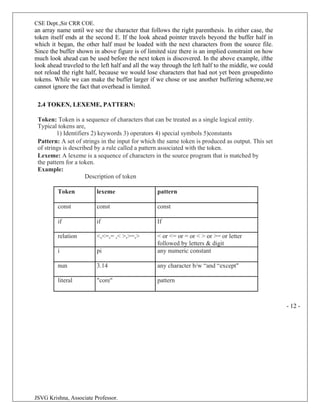

![CSE Dept.,Sir CRR COE.
JSVG Krishna, Associate Professor.
2.7 REGULAR EXPRESSIONS
Regular expression is a formula that describes a possible set of string.
Component of regular expression..
X the character x
. any character, usually accept a new line
[x y z] any of the characters x, y, z, …..
R? a R or nothing (=optionally as R)
R* zero or more occurrences…..
R+ one or more occurrences ……
R1R2 an R1 followed by an R2
R2R1 either an R1 or an R2.
A token is either a single string or one of a collection of strings of a certain type. If we view
the set of strings in each token class as an language, we can use the regular-expression
notation to describe tokens.
Consider an identifier, which is defined to be a letter followed by zero or more letters
or digits. In regular expression notation we would write.
Identifier = letter (letter | digit)*
Here are the rules that define the regular expression over alphabet .
o is a regular expression denoting { € }, that is, the language containing only the
empty string.
o For each „a‟ in ∑, is a regular expression denoting { a }, the language with only
one string consisting of the single symbol „a‟ .
o If R and S are regular expressions, then
(R) | (S) means LrULs
R.S means Lr.Ls
R* denotes Lr*
2.8 REGULAR DEFINITIONS
For notational convenience, we may wish to give names to regular expressions
and to define regular expressions using these names as if they were symbols.
Identifiers are the set or string of letters and digits beginning with a letter. The
following regular definition provides a precise specification for this class of string.
Example-1,
Ab*|cd? Is equivalent to (a(b*)) | (c(d?))
Pascal identifier
Letter -
Digits -
A | B | ……| Z | a | b |……| z|
0 | 1 | 2 | …. | 9
letter (letter / digit)* I](https://image.slidesharecdn.com/31compilerdesign-240226140600-10d4dc94/85/design-intoduction-of_COMPILER_DESIGN-pdf-20-320.jpg)
![CSE Dept.,Sir CRR COE.
JSVG Krishna, Associate Professor.
Recognition of tokens:
We learn how to express pattern using regular expressions. Now, we must study how to take
the patterns for all the needed tokens and build a piece of code that examins the input string
and finds a prefix that is a lexeme matching one of the patterns.
Stmt -> if expr then stmt
| If expr then else stmt
| є
Expr --> term relop term
|term
Term -->id
For relop ,we use the comparison operations of languages like Pascal or SQL where = is
“equals” and < > is “not equals” because it presents an interesting structure of lexemes. The
terminal of grammar, which are if, then , else, relop ,id and numbers are the names of tokens
as far as the lexical analyzer is concerned, the patterns for the tokens are described using
regular definitions.
digit -->[0,9]
digits -->digit+
number -->digit(.digit)?(e.[+-]?digits)?
letter -->[A-Z,a-z]
id -->letter(letter/digit)*
if --> if
then -->then
else -->else
relop --></>/<=/>=/==/< >
In addition, we assign the lexical analyzer the job stripping out white space, by recognizing
the “token” we defined by:
ws --> (blank/tab/newline)
+
Here, blank, tab and newline are abstract symbols that we use to express the ASCII
characters of the same names. Token ws is different from the other tokens in that ,when we
recognize it, we do not return it to parser ,but rather restart the lexical analysis from the
character that follows the white space . It is the following token that gets returned to the
parser.
Lexeme Token Name Attribute Value
Any ws _ _
if if _
then then _
else else _
Any Id id pointer to table entry
Any number number
pointer to table entry
< relop LT
- 15 -](https://image.slidesharecdn.com/31compilerdesign-240226140600-10d4dc94/85/design-intoduction-of_COMPILER_DESIGN-pdf-21-320.jpg)
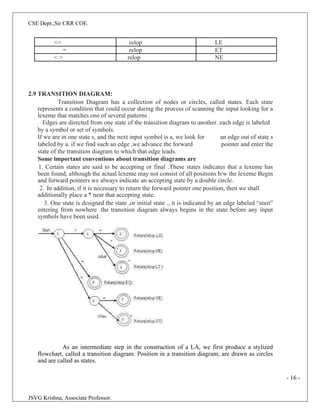




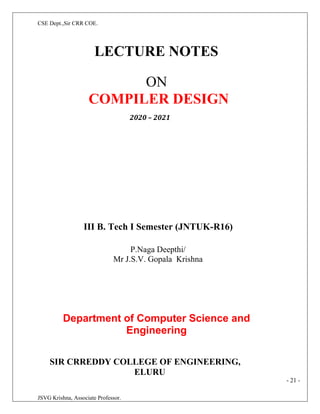

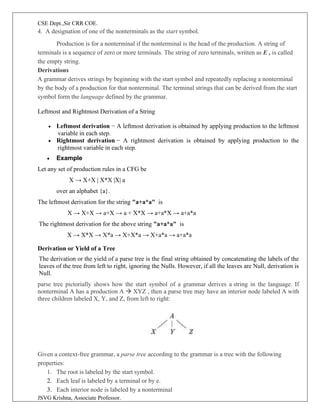

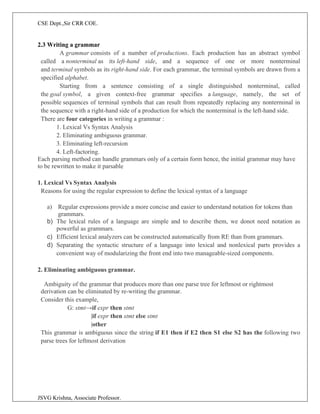



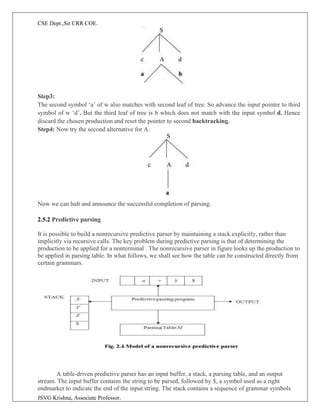
![CSE Dept.,Sir CRR COE.
JSVG Krishna, Associate Professor.
with $ on the bottom, indicating the bottom of the stack. Initially, the stack contains the start symbol of
the grammar on top of $. The parsing table is a two dimensional array M[A,a] where A is a nonterminal,
and a is a terminal or the symbol $. The parser is controlled by a program that behaves as follows. The
program considers X, the symbol on the top of the stack, and a, the current input symbol. These two
symbols determine the action of the parser. There are three possibilities.
1 If X= a=$, the parser halts and announces successful completion of parsing.
2 If X=a!=$, the parser pops X off the stack and advances the input pointer to the next input symbol.
3 If X is a nonterminal, the program consults entry M[X,a] of the parsing table M. This entry will be
either an X-production of the grammar or an error entry. If, for example, M[X,a]={X- >UVW}, the
parser replaces X on top of the stack by WVU( with U on top). As output, we shall assume that the
parser just prints the production used; any other code could be executed here. If M[X,a]=error, the
parser calls an error recovery routine
Implementation of predictive parser:
1. Elimination of left recursion, left factoring and ambiguous grammar.
2. Construct FIRST() and FOLLOW() for all non-terminals.
3. Construct predictive parsing table.
4. Parse the given input string using stack and parsing table
Algorithm for Nonrecursive predictive parsing.
Input. A string w and a parsing table M for grammar G.
Output. If w is in L(G), a leftmost derivation of w; otherwise, an error indication.
Method. Initially, the parser is in a configuration in which it has $S on the stack with S, the start symbol
of G on top, and w$ in the input buffer. The program that utilizes the predictive parsing table M to
produce a parse for the input is shown in Fig.
set ip to point to the first symbol of w$. repeat
let X be the top stack symbol and a the symbol pointed to by ip. if X is a terminal of $ then
if X=a then
pop X from the stack and advance ip else error()
else
if M[X,a]=X->Y1Y2...Yk then begin pop X from the stack;
push Yk,Yk-1...Y1 onto the stack, with Y1 on top; output the production X-> Y1Y2...Yk
end
else error()
until X=$ /* stack is empty */](https://image.slidesharecdn.com/31compilerdesign-240226140600-10d4dc94/85/design-intoduction-of_COMPILER_DESIGN-pdf-36-320.jpg)
![CSE Dept.,Sir CRR COE.
JSVG Krishna, Associate Professor.
2.5.3 FIRST AND FOLLOW
The construction of a predictive parsing table is aided by two functions associated with a grammar:
1. FIRST
2. FOLLOW
To compute FIRST(X) for all grammar symbols X, apply the following rules until no more
terminals or e can be added to any FIRST set.
Rules for FIRST ( ):
1. If X is terminal, then FIRST(X) is {X}.
2. If X → ε is a production, then add ε to FIRST(X).
3. If X is non-terminal and X → aα is a production then add a to FIRST(X).
4. If X is non-terminal and X → Y1 Y2…Yk is a production, then place a in FIRST(X) if for
some i, a is in FIRST(Yi), and ε is in all of FIRST(Y1),…,FIRST(Yi-1);that is,
Y1,….Yi-1=> ε. If ε is in FIRST(Yj) for all j=1,2,..,k, then add ε to FIRST(X).
Rules for FOLLOW ( ):
1. If S is a start symbol, then FOLLOW(S) contains $.
2. If there is a production A → αBβ, then everything in FIRST(β) except ε is placed in
follow(B).
3. If there is a production A → αB, or a production A → αBβ where FIRST(β) contains
ε, then everything in FOLLOW(A) is in FOLLOW(B).
2.5.4 Algorithm for construction of predictive parsing table:
Input : Grammar G
Output : Parsing table M
Method :
1. For each production A → α of the grammar, do steps 2 and 3.
2. For each terminal a in FIRST(α), add A → α to M[A, a].
3. If ε is in FIRST(α), add A → α to M[A, b] for each terminal b in FOLLOW(A). If ε is in
FIRST(α) and $ is in FOLLOW(A) , add A → α to M[A, $].
4. Make each undefined entry of M be error.](https://image.slidesharecdn.com/31compilerdesign-240226140600-10d4dc94/85/design-intoduction-of_COMPILER_DESIGN-pdf-37-320.jpg)

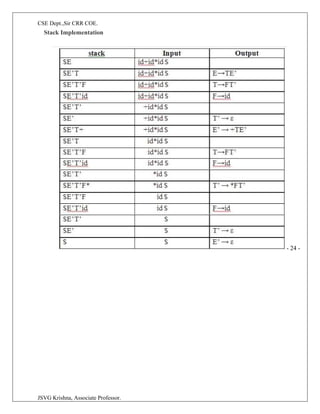
![CSE Dept.,Sir CRR COE.
JSVG Krishna, Associate Professor.
2.5.5.LL(1) GRAMMAR
The parsing table algorithm can be applied to any grammar G to produce a parsing table M.
For some Grammars, for example if G is left recursive or ambiguous, then M will have at
least one multiply-defined entry. A grammar whose parsing table has no multiply defined
entries is said to be LL(1). It can be shown that the above algorithm can be used to produce
for every LL(1) grammar G, a parsing table M that parses all and only the sentences of G.
LL(1) grammars have several distinctive properties. No ambiguous or left recursive grammar
can be LL(1). There remains a question of what should be done in case of multiply defined
entries. One easy solution is to eliminate all left recursion and left factoring, hoping to
produce a grammar which will produce no multiply defined entries in the parse tables.
Unfortunately there are some grammars which will give an LL(1) grammar after any kind of
alteration. In general, there are no universal rules to convert multiply defined entries into
single valued entries without affecting the language recognized by the parser.
The main difficulty in using predictive parsing is in writing a grammar for the source
language such that a predictive parser can be constructed from the grammar. Although left
recursion elimination and left factoring are easy to do, they make the resulting grammar hard
to read and difficult to use the translation purposes. To alleviate some of this difficulty, a
common organization for a parser in a compiler is to use a predictive parser for control
constructs and to use operator precedence for expressions.however, if an lr parser generator
is available, one can get all the benefits of predictive parsing and operator precedence
automatically.
2.5.6.ERROR RECOVERY IN PREDICTIVE PARSING
The stack of a nonrecursive predictive parser makes explicit the terminals and nonterminals
that the parser hopes to match with the remainder of the input. We shall therefore refer to
symbols on the parser stack in the following discussion. An error is detected during
predictive parsing when the terminal on top of the stack does not match the next input
symbol or when nonterminal A is on top of the stack, a is the next input symbol, and the
parsing table entry M[A,a] is empty.
Consider error recovery predictive parsing using the following two methods
Panic-Mode recovery
Phrase Level recovery
Panic-mode error recovery is based on the idea of skipping symbols on the input until a
token in a selected set of synchronizing tokens appears. Its effectiveness depends on the
choice of synchronizing set. The sets should be chosen so that the parser recovers quickly
from errors that are likely to occur in practice.
As a starting point, we can place all symbols in FOLLOW(A) into the synchronizing set for
nonterminal A. If we skip tokens until an element of FOLLOW(A) is seen and pop A from
the stack, it is likely that parsing can continue.
It is not enough to use FOLLOW(A) as the synchronizingset for A. Fo example , if
semicolons terminate statements, as in C, then keywords that begin statements may not
appear in the FOLLOW set of the nonterminal generating expressions. A missing semicolon
after an assignment may therefore result in the keyword beginning the next statement being
skipped. Often, there is a hierarchica structure on constructs in a language; e.g., expressions
appear within statement, which appear within bblocks,and so on. We can add to the](https://image.slidesharecdn.com/31compilerdesign-240226140600-10d4dc94/85/design-intoduction-of_COMPILER_DESIGN-pdf-40-320.jpg)

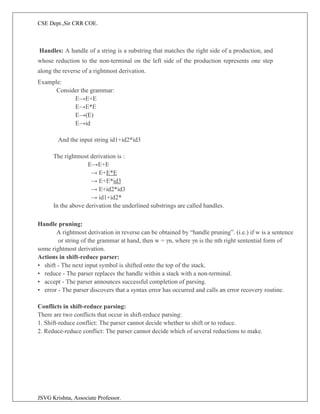
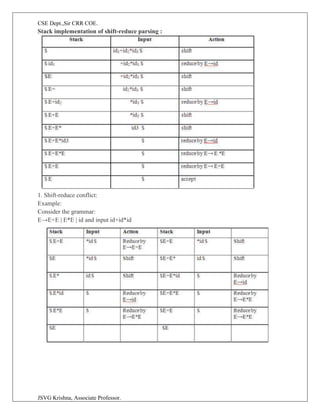

![CSE Dept.,Sir CRR COE.
JSVG Krishna, Associate Professor.
The LR parsing algorithm:
The schematic form of an LR parser is as follows:
It consists of an input, an output, a stack, a driver program, and a pa parts (action and goto).
a. The driver program is the same for all LR parser.
b. The parsing program reads characters from an input buffer one at a time.
c. The program uses a stack to store a string of the form s0X1s1X2s2…Xmsm, where sm is
on top. Each Xi is a grammar symbol and each si is a state.
d. The parsing table consists of two parts : action and goto functions.
Action : The parsing program determines sm, the state currently on top of stack, and ai, the current
input symbol. It then consults action[sm,ai] in the action table which can have one of four values:
1. shift s, where s is a state,
2. reduce by a grammar production A → β,
3. accept,
4. Error.
Goto : The function goto takes a state and grammar symbol as arguments and produces a state.
LR Parsing algorithm:
Input: An input string w and an LR parsing table with functions action and goto for grammar G.
Output: If w is in L(G), a bottom-up-parse for w; otherwise, an error indication.
Method: Initially, the parser has s0 on its stack, where s0 is the initial state, and w$ in the input buffer.
The parser then executes the following program:](https://image.slidesharecdn.com/31compilerdesign-240226140600-10d4dc94/85/design-intoduction-of_COMPILER_DESIGN-pdf-45-320.jpg)
![CSE Dept.,Sir CRR COE.
JSVG Krishna, Associate Professor.
set ip to point to the first input symbol of w$; repeat forever begin
let s be the state on top of the stack and a the symbol pointed to by ip;
if action[s, a] = shift s’ then begin
push a then s’ on top of the stack; advance ip to the next input symbol end
else if action[s, a] = reduce A→β then begin pop 2* | β | symbols off the stack;
let s’ be the state now on top of the stack; push A then goto[s’, A] on top of the stack; output the
production A→ β
end
else if action[s, a] = accept then
return
else error( )
end
CONSTRUCTING SLR(1) PARSING TABLE
To perform SLR parsing, take grammar as input and do the following:
1. Find LR(0) items.
2. Completing the closure.
3. Compute goto(I,X), where, I is set of items and X is grammar symbol.
LR(0) items:
An LR(0) item of a grammar G is a production of G with a dot at some position of the right side. For
example, production A → XYZ yields the four items :
A→.XYZ
A → X . YZ
A → XY . Z
A → XYZ .
Closure operation:
If I is a set of items for a grammar G, then closure(I) is the set of items constructed from I by
the two rules:
1. Initially, every item in I is added to closure(I).
2. If A → α . Bβ is in closure(I) and B → γ is a production, then add the item B → . γ to I , if it
is not already there. We apply this rule until no more new items can be added to closure(I).
Goto operation:
Goto(I, X) is defined to be the closure of the set of all items [A→ αX . β] such that [A→ α . Xβ] is in I.
Steps to construct SLR parsing table for grammar G are:
1. Augment G and produce G’
2. Construct the canonical collection of set of items C for G’
3. Construct the parsing action function action and goto using the following algorithm that requires
FOLLOW(A) for each non-terminal of grammar.](https://image.slidesharecdn.com/31compilerdesign-240226140600-10d4dc94/85/design-intoduction-of_COMPILER_DESIGN-pdf-46-320.jpg)
![CSE Dept.,Sir CRR COE.
JSVG Krishna, Associate Professor.
Algorithm for construction of SLR parsing table:
Input : An augmented grammar G’
Output : The SLR parsing table functions action and goto for G’
Method :
1. Construct C = {I0, I1, …. In}, the collection of sets of LR(0) items for G’.
2. State i is constructed from Ii.. The parsing functions for state i are determined as
follows:
(a) If [A→α∙aβ] is in Ii and goto(Ii,a) = Ij, then set action[i,a] to “shift j”. Here a must be
terminal.
(b) If [A→α∙] is in Ii , then set action[i,a] to “reduce A→α” for all a in FOLLOW(A).
(c) If [S’→S.] is in Ii, then set action[i,$] to “accept”.
If any conflicting actions are generated by the above rules, we say grammar is not SLR(1).
3. The goto transitions for state i are constructed for all non-term
If goto(Ii,A) = Ij, then goto[i,A] = j.
4. All entries not defined by rules (2) and (3) are made “error”
5. The initial state of the parser is the one constructed from the [S’→.S].
Example on SLR ( 1 ) Grammar
S → E
E → E + T | T
T → T * F | F
F → id
Add Augment Production and insert '•' symbol at the first position for every production in G
S` → •E
E → •E + T
E → •T
T → •T * F
T → •F
F → •id
I0 State:
Add Augment production to the I0 State and Compute the Closure
I0 = Closure (S` → •E)
Add all productions starting with E in to I0 State because "." is followed by the non-terminal. So, the I0
State becomes
I0 = S` → •E
E → •E + T
E → •T
Add all productions starting with T and F in modified I0 State because "." is followed by the non-
terminal. So, the I0 State becomes.](https://image.slidesharecdn.com/31compilerdesign-240226140600-10d4dc94/85/design-intoduction-of_COMPILER_DESIGN-pdf-47-320.jpg)




![CSE Dept.,Sir CRR COE.
JSVG Krishna, Associate Professor.
UNIT –III
More Powerful LR parser (LR1,LALR) Using Armigers Grammars Equal Recovery in Lr parser
Syntax Directed Transactions Definition, Evolution order of SDTS Application of SDTS. Syntax
Directed Translation Schemes.
UNIT -3
3.1 CANONICAL LR PARSING
CLR refers to canonical lookahead. CLR parsing use the canonical collection of LR (1) items to build
the CLR (1) parsing table. CLR (1) parsing table produces the more number of states as compare to the
SLR (1) parsing.
In the CLR (1), we place the reduce node only in the lookahead symbols.
Various steps involved in the CLR (1) Parsing:
1) For the given input string write a context free grammar
2) Check the ambiguity of the grammar
3) Add Augment production in the given grammar
4) Create Canonical collection of LR (0) items
5) Draw a data flow diagram (DFA)
6) Construct a CLR (1) parsing table
In the SLR method we were working with LR(0)) items. In CLR parsing we will be using LR(1)
items. LR(k) item is defined to be an item using lookaheads of length k. So ,the LR(1) item is
comprised of two parts : the LR(0) item and the lookahead associated with the item. The look ahead
is used to determine that where we place the final item. The look ahead always add $ symbol for the
argument production.
LR(1) parsers are more powerful parser.
for LR(1) items we modify the Closure and GOTO function.
Closure Operation
Closure(I)
repeat
for (each item [ A -> ?.B?, a ] in I )
for (each production B -> ? in G’)
for (each terminal b in FIRST(?a))
add [ B -> .? , b ] to set I;
until no more items are added to I;
return I;](https://image.slidesharecdn.com/31compilerdesign-240226140600-10d4dc94/85/design-intoduction-of_COMPILER_DESIGN-pdf-52-320.jpg)
![CSE Dept.,Sir CRR COE.
JSVG Krishna, Associate Professor.
Goto Operation
Goto(I, X)
Initialise J to be the empty set;
for ( each item A -> ?.X?, a ] in I )
Add item A -> ?X.?, a ] to se J; /* move the dot one step */
return Closure(J); /* apply closure to the set */
LR(1) items
Void items(G’)
Initialise C to { closure ({[S’ -> .S, $]})};
Repeat
For (each set of items I in C)
For (each grammar symbol X)
if( GOTO(I, X) is not empty and not in C)
Add GOTO(I, X) to C;
Until no new set of items are added to C;
3.2 ALGORITHM FOR CONSTRUCTION OF THE CANONICAL LR PARSING
TABLE
Input: grammar G'
Output: canonical LR parsing table functions action and goto
1. Construct C = {I0, I1 , ..., In} the collection of sets of LR(1) items for G'.State i
is constructed from Ii.
2. if [A -> a.ab, b>] is in Ii and goto(Ii, a) = Ij, then set action[i, a] to "shift j". Here
a must be a terminal.
3. if [A -> a., a] is in Ii, then set action[i, a] to "reduce A -> a" for all a in
FOLLOW(A). Here A may not be S'.
4. if [S' -> S.] is in Ii, then set action[i, $] to "accept"
5. If any conflicting actions are generated by these rules, the grammar is not
LR(1) and the algorithm fails to produce a parser.
6. The goto transitions for state i are constructed for all nonterminals A using the
rule: If goto(Ii, A)= Ij, then goto[i, A] = j.
7. All entries not defined by rules 2 and 3 are made "error".
8. The inital state of the parser is the one constructed from the set of items
containing [S' -> .S, $].](https://image.slidesharecdn.com/31compilerdesign-240226140600-10d4dc94/85/design-intoduction-of_COMPILER_DESIGN-pdf-53-320.jpg)

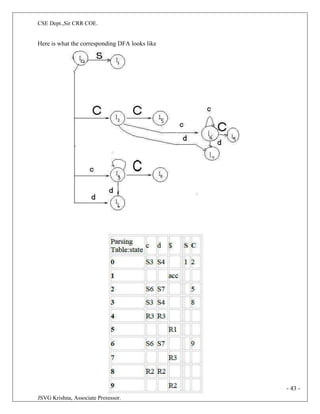



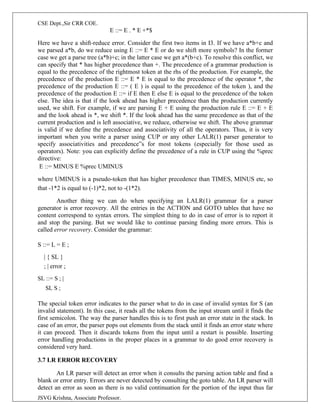
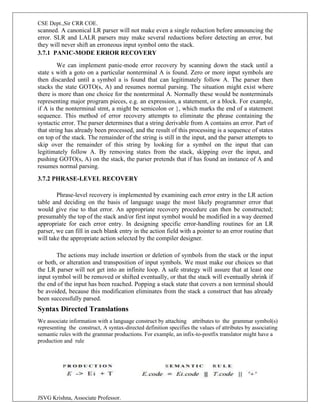





![CSE Dept.,Sir CRR COE.
JSVG Krishna, Associate Professor.
third type of line, shown dashed, represents the values of E.node and T-node; each line points to the
appropriate syntax-tree node.
.
2 The Structure of a Type
The type int [2][3] can be read as, "array of 2 arrays of 3 integers." The corresponding type
expression array(2, array(3, integer)) is represented by the tree in Fig. 5.15. The operator array takes
two parameters, a number and a type. If types are represented by trees, then this operator returns a tree
node labeled array with two children for a number and a type.
Nonterminal B generates one of the basic types int and float. T generates a basic type when T derives B
C and C derives e. Otherwise, C generates array components consisting of a sequence of integers, each
integer surrounded by brackets.](https://image.slidesharecdn.com/31compilerdesign-240226140600-10d4dc94/85/design-intoduction-of_COMPILER_DESIGN-pdf-66-320.jpg)
![CSE Dept.,Sir CRR COE.
JSVG Krishna, Associate Professor.
An annotated parse tree for the input string int [ 2 ] [ 3 ] is shown in Fig. 5.17. The corresponding type
expression in Fig. 5.15 is constructed by passing the type integer from B, down the chain of C's through
the inherited attributes b. The array type is synthesized up the chain of C's through the attributes t.
In more detail, at the root for T -» B C, nonterminal C inherits the type from B, using the inherited
attribute C.b. At the rightmost node for C, the production is C e, so C.t equals C.6. The semantic rules
for the production C [ num ] C1 form C.t by applying the operator array to the operands num.ua/ and
C1.t.](https://image.slidesharecdn.com/31compilerdesign-240226140600-10d4dc94/85/design-intoduction-of_COMPILER_DESIGN-pdf-67-320.jpg)

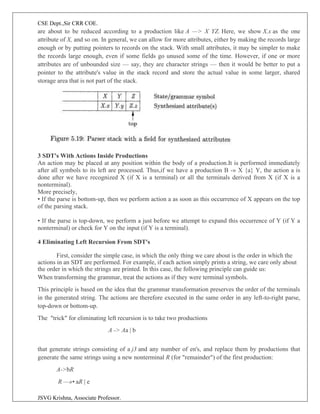

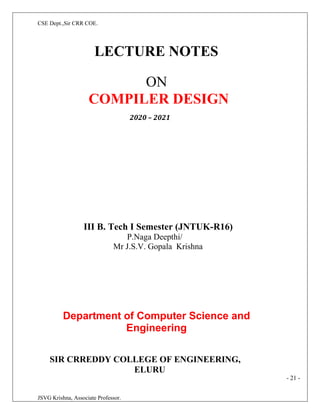
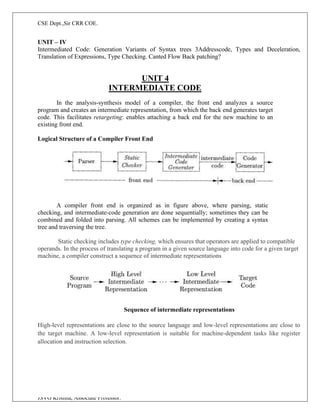


![CSE Dept.,Sir CRR COE.
JSVG Krishna, Associate Professor.
If the condition “x relop y” gets satisfied, then-
The control is sent directly to the location specified by label X.
All the statements in between are skipped.
If the condition “x relop y” fails, then-
The control is not sent to the location specified by label X.
The next statement appearing in the usual sequence is executed.
4. Unconditional Jump- goto X
On executing the statement,The control is sent directly to the location specified by label X.
All the statements in between are skipped.
5. Procedure Call- param x call p return y
Here, p is a function which takes x as a parameter and returns y.
For a procedure call p(x1, …, xn)
param x1
…
param xn
call p, n
6.Indexed copy instructions: x = y[i] and x[i] = y
Left: sets x to the value in the location i memory units beyond y
Right: sets the contents of the location i memory units beyond x to y
7.Address and pointer instructions:
x = &y sets the value of x to be the location (address) of y.
x = *y, presumably y is a pointer or temporary whose value is a
location. The value of x is set to the contents of that location.
*x = y sets the value of the object pointed to by x to the value of y.
Data Structure
Three address code is represented as record structure with fields for operator and
operands. These records can be stored as array or linked list. Most common
implementations of three address code are Quadruples, Triples and Indirect triples.
2. Quadruples
Quadruples consists of four fields in the record structure. One field to store operator op, two
fields to store operands or arguments arg1and arg2 and one field to store result res.
res = arg1 op arg2
Example: a = b + c
b is represented as arg1, c is represented as arg2, + as op and a as res.](https://image.slidesharecdn.com/31compilerdesign-240226140600-10d4dc94/85/design-intoduction-of_COMPILER_DESIGN-pdf-75-320.jpg)

![CSE Dept.,Sir CRR COE.
JSVG Krishna, Associate Professor.
3 TRIPLES
Triples uses only three fields in the record structure. One field for operator, two fields for
operands named as arg1 and arg2. Value of temporary variable can be accessed by the
position of the statement the computes it and not by location as in quadruples.
Example: a = -b * d + c + (-b) * d
Triples for the above example is as follows
Arg1 and arg2 may be pointers to symbol table for program variables or literal table
for constant or pointers into triple structure for intermediate results.
Example: Triples for statement x[i] = y which generates two records is as follows](https://image.slidesharecdn.com/31compilerdesign-240226140600-10d4dc94/85/design-intoduction-of_COMPILER_DESIGN-pdf-77-320.jpg)
![CSE Dept.,Sir CRR COE.
JSVG Krishna, Associate Professor.
Triples for statement x = y[i] which generates two records is as follows
Triples are alternative ways for representing syntax tree or Directed acyclic graph
for program defined names.
Indirect Triples
Indirect triples are used to achieve indirection in listing of pointers. That is, it uses pointers
to triples than listing of triples themselves.
Example: a = -b * d + c + (-b) * d](https://image.slidesharecdn.com/31compilerdesign-240226140600-10d4dc94/85/design-intoduction-of_COMPILER_DESIGN-pdf-78-320.jpg)
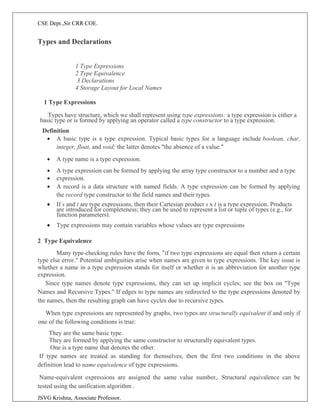

![CSE Dept.,Sir CRR COE.
JSVG Krishna, Associate Professor.
The body of the T-production consists of nonterminal B, an action, and nonterminal C, which
appears on the next line. The action between B and C sets t to B.type and w to B. width. If B —>• int
then B.type is set to integer and B.width is set to 4, the width of an integer. Similarly, if B -+ float then
B.type is float and B.width is 8, the width of a float.
The productions for C determine whether T generates a basic type or an array type. If C —>• e,
then t becomes C.type and w becomes C. width. Otherwise, C specifies an array component. The action
for C —> [ n u m ] C1 forms C.type by applying the type constructor array to the operands num.value
and C1.type.
The width of an array is obtained by multiplying the width of an element by the number of
elements in the array. If addresses of consecutive integers differ by 4, then address calculations for an
array of integers will include multiplications by 4. Such multiplications provide opportunities for
optimization, so it is helpful for the front end to make them explicit.
Example The parse tree for the type i n t [2] [3] is shown by dotted lines in Fig. 6.16. The solid lines
show how the type and width are passed from B, down the chain of C's through variables t and w, and
then back up the chain as synthesized attributes type and width. The variables t and w are assigned the
values of B.type and B.width, respectively, before the subtree with the C nodes is examined. The values
of t and w are used at the node for C —> e to start the evaluation of the synthesized attributes up the
chain of C nodes.](https://image.slidesharecdn.com/31compilerdesign-240226140600-10d4dc94/85/design-intoduction-of_COMPILER_DESIGN-pdf-81-320.jpg)
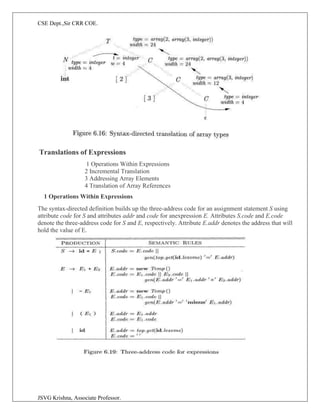
![CSE Dept.,Sir CRR COE.
JSVG Krishna, Associate Professor.
Example The syntax-directed definition in Fig. 6.19 translates the assignment statement
a = b + - c; into the TAC
2 Incremental Translation
Code attributes can be long strings, so they are generated incrementally In the incremental
approach, gen not only constructs a three-address instruction, it appends the instruction to the sequence
of instructions generated so far. The sequence may either be retained in memory for further processing,
or it may be output incrementally.attribute addr represents the address of a node rather than a variable or
constant.
3.Addressing Array Elements
Elements of arrays can be accessed quickly if the elements are stored in a block of consecutive
location. Array can be one dimensional or two dimensional.
For one dimensional array:
A: array[low..high] of the ith elements is at:
base + (i-low)*width = i*width + (base - low*width)
Multi-dimensional arrays:
Row major or column major forms
o Row major: a[1,1], a[1,2], a[1,3], a[2,1], a[2,2], a[2,3]
o Column major: a[1,1], a[2,1], a[1, 2], a[2, 2],a[1, 3],a[2,3]
o In row major form, the address of a[i1, i2] is
o Base+((i1-low1)*(high2-low2+1)+i2-low2)*width](https://image.slidesharecdn.com/31compilerdesign-240226140600-10d4dc94/85/design-intoduction-of_COMPILER_DESIGN-pdf-83-320.jpg)
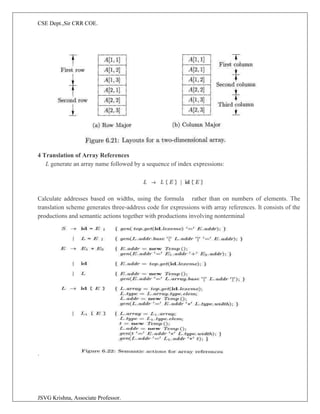




















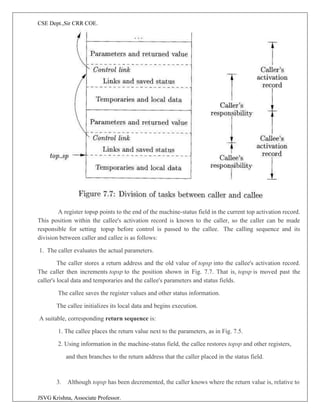
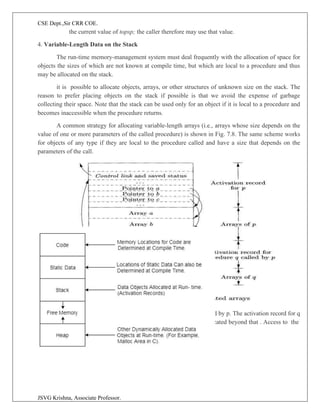




![CSE Dept.,Sir CRR COE.
JSVG Krishna, Associate Professor.
8. Displays
One problem with the access-link approach to nonlocal data is that if the nesting depth gets large, we
may have to follow long chains of links to reach the data we need. A more efficient implementation
uses an auxiliary array d, called the display, which consists of one pointer for each nesting depth. We
arrange that, at all times, d[i] is a pointer to the highest activation record on the stack for any procedure
at nesting depth i. Examples of a display are shown in Fig. 7.14.
In order to maintain the display correctly, we need to save previous values of display entries in
new activation records.](https://image.slidesharecdn.com/31compilerdesign-240226140600-10d4dc94/85/design-intoduction-of_COMPILER_DESIGN-pdf-111-320.jpg)

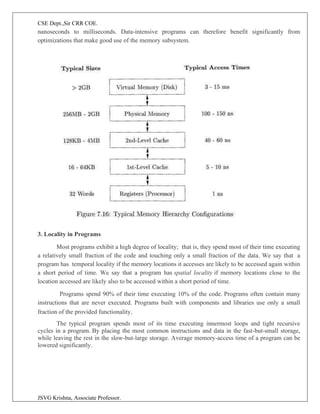








![CSE Dept.,Sir CRR COE.
JSVG Krishna, Associate Professor.
1. t1:= x * x
2. t2:= x * y
3. t3:= 2 * t2
4. t4:= t1 + t3
5. t5:= y * y
6. t6:= t4 + t5
Basic block construction:
Algorithm: Partition into basic blocks
Input: It contains the sequence of three address statements
Output: it contains a list of basic blocks with each three address statement in exactly one block
Method: First identify the leader in the code. The rules for finding leaders are as follows:
o The first statement is a leader.
o Statement L is a leader if there is an conditional or unconditional goto statement like: if....goto
L or goto L
o Instruction L is a leader if it immediately follows a goto or conditional goto statement like: if
goto B or goto B
For each leader, its basic block consists of the leader and all statement up to. It doesn't include the next
leader or end of the program.
Consider the following source code for dot product of two vectors a and b of length 10:
begin
prod :=0;
i:=1;
do begin
prod :=prod+ a[i] * b[i];
i :=i+1;
end
while i <= 10
end
The three address code for the above source program is given below:
B1
(1) prod := 0
(2) i := 1](https://image.slidesharecdn.com/31compilerdesign-240226140600-10d4dc94/85/design-intoduction-of_COMPILER_DESIGN-pdf-122-320.jpg)
![CSE Dept.,Sir CRR COE.
JSVG Krishna, Associate Professor.
B2
(3) t1 := 4* i
(4) t2 := a[t1]
(5) t3 := 4* i
(6) t4 := b[t3]
(7) t5 := t2*t4
(8) t6 := prod+t5
(9) prod := t6
(10) t7 := i+1
(11) i := t7
(12) if i<=10 goto (3)
Basic block B1 contains the statement (1) to (2)
Basic block B2 contains the statement (3) to (12)
Flow Graph
Flow graph is a directed graph. It contains the flow of control information for the set of basic block.
A control flow graph is used to depict that how the program control is being parsed among the blocks. It
is useful in the loop optimization.Flow graph for the vector dot product is given as follows:
1.Block B1 is the initial node. Block B2 immediately follows B1, so from B2 to B1 there is an
edge.
2.The target of jump from last statement of B1 is the first statement B2, so from B1 to B2 there
is an edge.](https://image.slidesharecdn.com/31compilerdesign-240226140600-10d4dc94/85/design-intoduction-of_COMPILER_DESIGN-pdf-123-320.jpg)
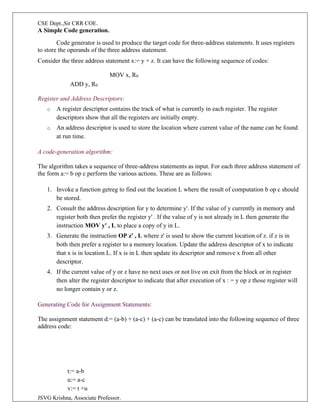


![CSE Dept.,Sir CRR COE.
JSVG Krishna, Associate Professor.
UNIT–VI
Machine Independent Optimization. The principle sources of Optimization, peep hole Optimization,
Introduction to Date flow Analysis.
UNIT 6
MACHINE INDEPENDENT OPTIMIZATION
Elimination of unnecessary instructions in object code, or the replacement of one sequence of
instructions by a faster sequence of instructions that does the same thing is usually called "code
improvement" or "code optimization."
Optimizations are classified into two categories.
1. Machine independent optimizations:
Machine independent optimizations are program transformations that improve the target
code without taking into consideration any properties of the target machine
2. Machine dependant optimizations:
Machine dependant optimizations are based on register allocation and utilization of special
machine-instruction sequences.
The Principal Sources of Optimization
A transformation of a program is called local if it can be performed by looking only at the
statements in a basic block; otherwise, it is called global. Many transformations can be performed at
both the local and global levels.
Function-Preserving Transformations: There are a number of ways in which a compiler can improve
a program without changing the function it computes.
: Common sub expression elimination
Copy propagation,
Dead-code elimination
Constant folding
Common Sub expressions elimination:
An occurrence of an expression E is called a common sub-expression if E was previously
computed, and the values of variables in E have not changed since the previous computation. We can
avoid recomputing the expression if we can use the previously computed value.
• For example
t1: = 4*i
t2: = a [t1]
t3: = 4*j
t4: = 4*i
t5: = n
t6: = b [t4] +t5](https://image.slidesharecdn.com/31compilerdesign-240226140600-10d4dc94/85/design-intoduction-of_COMPILER_DESIGN-pdf-127-320.jpg)
![CSE Dept.,Sir CRR COE.
JSVG Krishna, Associate Professor.
The above code can be optimized using the common sub-expression elimination as
t1: = 4*i
t2: = a [t1]
t3: = 4*j
t5: = n
t6: = b [t1] +t5
The common sub expression t4: =4*i is eliminated as its computation is already in t1 and the value of i
is not been changed from definition to use.
Copy Propagation:
Assignments of the form f : = g called copy statements, or copies for short. The idea behind the
copy-propagation transformation is to use g for f, whenever possible after the copy statement f: = g.
Copy propagation means use of one variable instead of another.
• For example:
x=Pi;
A=x*r*r;
The optimization using copy propagation can be done as follows: A=Pi*r*r;
Here the variable x is eliminated
Dead-Code Eliminations:
A variable is live at a point in a program if its value can be used subsequently; otherwise, it is
dead at that point.
Example:
i=0;
if(i==1)
{
a=b+5;
}
Here, ‘if’ statement is dead code because this condition will never get satisfied.
Constant folding:
Deducing at compile time that the value of an expression is a constant and using the constant
instead is known as constant folding. One advantage of copy propagation is that it often turns the copy
statement into dead code.
For example,
a=3.14157/2 can be replaced by
a=1.570](https://image.slidesharecdn.com/31compilerdesign-240226140600-10d4dc94/85/design-intoduction-of_COMPILER_DESIGN-pdf-128-320.jpg)
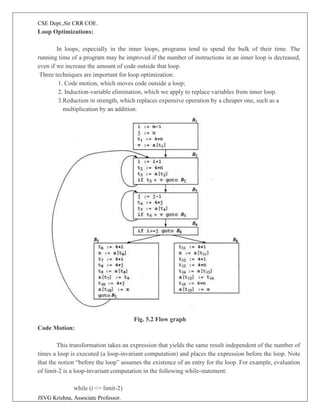
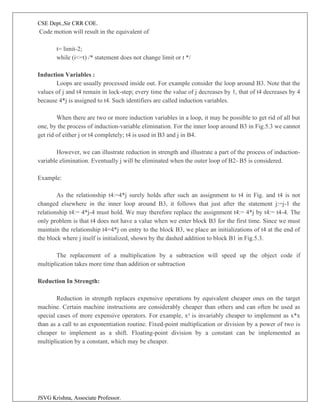





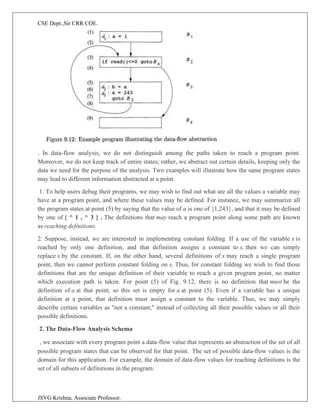
![CSE Dept.,Sir CRR COE.
JSVG Krishna, Associate Professor.
A particular data-flow value is a set of definitions, and we want to associate with each point in the
program the exact set of definitions that can reach that point. As discussed above, the choice of
abstraction depends on the goal of the analysis; to be efficient, we only keep track of information that is
relevant.
Denote the data-flow values before and after each statement s by IN[S ] and OUT[s], respectively.
The data-flow problem is to find a solution to a set of constraints on the IN[S]'S and OUT[s]'s, for all
statements s. There are two sets of constraints: those based on the semantics of the statements ("transfer
functions") and those based on the flow of control.
Transfer Functions
The data-flow values before and after a statement are constrained by the semantics of the statement. For
example, suppose our data-flow analysis involves determining the constant value of variables at points.
If variable a has value v before executing statement b = a, then both a and b will have the value v after
the statement. This relationship between the data-flow values before and after the assignment
statement is known as a transfer function.
Transfer functions come in two flavors: information may propagate forward along execution paths, or it
may flow backwards up the execution paths. In a forward-flow problem, the transfer function of a
statement s, which we shall usually denote f(a), takes the data-flow value before the statement and
produces a new data-flow value after the statement. That is,
Conversely, in a backward-flow problem, the transfer function f(a) for statement 8 converts a data-flow
value after the statement to a new data-flow value before the statement. That is,
Control – Flow Constraints
The second set of constraints on data-flow values is derived from the flow of control. Within a basic
block, control flow is simple. If a block B consists of statements s1, s 2 , • • • ,sn in that order, then the
control-flow value out of Si is the same as the control-flow value into Si+i. That is,
However, control-flow edges between basic blocks create more complex constraints between the last
statement of one basic block and the first statement of the following block. For example, if we are
interested in collecting all the definitions that may reach a program point, then the set of definitions
reaching the leader statement of a basic block is the union of the definitions after the last statements of
each of the predecessor blocks. The next section gives the details of how data flows among the blocks.](https://image.slidesharecdn.com/31compilerdesign-240226140600-10d4dc94/85/design-intoduction-of_COMPILER_DESIGN-pdf-137-320.jpg)
![CSE Dept.,Sir CRR COE.
JSVG Krishna, Associate Professor.
3. Data-Flow Schemas on Basic Blocks
While a data-flow schema involves data-flow values at each point in the program, we can save time
and space by recognizing that what goes on inside a block is usually quite simple. Control flows from
the beginning to the end of the block, without interruption or branching. Thus, we can restate the
schema in terms of data-flow values entering and leaving the blocks. We denote the data-flow values
immediately before and immediately after each basic block B by m[B] and 0 U T [ S ] , respectively.
The constraints involving m[B] and 0UT[B] can be derived from those involving w[s] and OUT[s] for
the various statements s in B as follows.
Suppose block B consists of statements s 1 , . . . , sn, in that order. If si is the first statement of basic
block B, then m[B] = I N [ S I ] , Similarly, if sn is the last statement of basic block B, then OUT[S] =
OUT[s„] . The transfer function of a basic block B, which we denote fB, can be derived by composing
the transfer functions of the statements in the block. That is, let fa. be the transfer function of
statement st. Then of statement si. Then fB = f,sn, o . . . o f,s2, o fsl. . The relationship between the
beginning and end of the block is
The constraints due to control flow between basic blocks can easily be rewritten by
substituting IN[B] and OUT[B] for IN[SI ] and OUT[sn], respectively. For instance, if data-flow values
are information about the sets of constants that may be assigned to a variable, then we have a forward-
flow problem in which
When the data-flow is backwards as we shall soon see in live-variable analy-sis, the equations are
similar, but with the roles of the IN's and OUT's reversed. That is,
Unlike linear arithmetic equations, the data-flow equations usually do not have a unique solution. Our
goal is to find the most "precise" solution that satisfies the two sets of constraints: control-flow and
transfer constraints. That is, we need a solution that encourages valid code improvements, but does not
justify unsafe transformations — those that change what the program computes.
4. Reaching Definitions](https://image.slidesharecdn.com/31compilerdesign-240226140600-10d4dc94/85/design-intoduction-of_COMPILER_DESIGN-pdf-138-320.jpg)
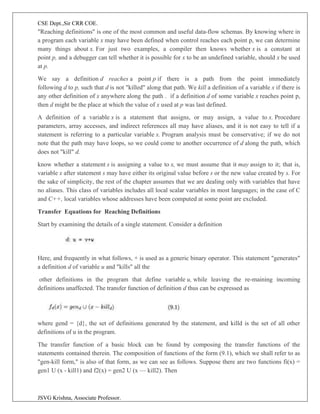

![CSE Dept.,Sir CRR COE.
JSVG Krishna, Associate Professor.
not "killed" by a subsequent definition to the same variable inside the same basic block. A basic block's
kill set is simply the union of all the definitions killed by the individual statements. Notice that a
definition may appear in both the gen and kill set of a basic block. If so, the fact that it is in gen takes
precedence, because in gen-kill form, the kill set is applied before the gen set.
Example 9 . 1 0 : The gen set for the basic block
is {d2} since d1 is not downwards exposed. The kill set contains both d1 and d2, since d1 kills d2
and vice versa. Nonetheless, since the subtraction of the kill set precedes the union operation with the
gen set, the result of the transfer function for this block always includes definition d2.
Control - Flow Equations
Next, we consider the set of constraints derived from the control flow between basic blocks. Since a
definition reaches a program point as long as there exists at least one path along which the definition
reaches, O U T [ P ] C m[B] whenever there is a control-flow edge from P to B. However, since a
definition cannot reach a point unless there is a path along which it reaches, w[B] needs to be no larger
than the union of the reaching definitions of all the predecessor blocks. That is, it is safe to assume
We refer to union as the meet operator for reaching definitions. In any data-flow schema, the meet
operator is the one we use to create a summary of the contributions from different paths at the
confluence of those paths.
Iterative Algorithm for Reaching Definitions
We assume that every control-flow graph has two empty basic blocks, an ENTRY node, which
represents the starting point of the graph, and an EXIT node to which all exits out of the graph go.
Since no definitions reach the beginning of the graph, the transfer function for the ENTRY block is a
simple constant function that returns 0 as an answer. That is, O U T [ E N T R Y ] = 0.
The reaching definitions problem is defined by the following equations:](https://image.slidesharecdn.com/31compilerdesign-240226140600-10d4dc94/85/design-intoduction-of_COMPILER_DESIGN-pdf-141-320.jpg)
![CSE Dept.,Sir CRR COE.
JSVG Krishna, Associate Professor.
These equations can be solved using the following algorithm. The result of the algorithm is the least
fixedpoint of the equations, i.e., the solution whose assigned values to the IN ' s and OUT's is contained
in the corresponding values for any other solution to the equations. The result of the algorithm below is
acceptable, since any definition in one of the sets IN or OUT surely must reach the point described. It is
a desirable solution, since it does not include any definitions that we can be sure do not reach.
A l g o r i t h m 9 . 1 1 : Reaching definitions.
INPUT: A flow graph for which kills and genB have been computed for each block B.
OUTPUT: I N [ B ] and O U T [ B ] , the set of definitions reaching the entry and exit of each
block B of the flow graph.
METHOD: We use an iterative approach, in which we start with the "estimate" OUT[JB] = 0 for
all B and converge to the desired values of IN and OUT. As we must iterate until the IN ' s (and hence
the OUT's) converge, we could use a boolean variable change to record, on each pass through the
blocks, whether any OUT has changed. However, in this and in similar algorithms described later, we
assume that the exact mechanism for keeping track of changes is understood, and we elide those details.
The algorithm is sketched in Fig. 9.14. The first two lines initialize certain data-flow values.4
Line (3)
starts the loop in which we iterate until convergence, and the inner loop of lines (4) through (6) applies
the data-flow equations to every block other than the entry. •
Algorithm 9.11 propagates definitions as far as they will go with-out being killed, thus simulating all
possible executions of the program. Algo-rithm 9.11 will eventually halt, because for every B, OUT[B]
never shrinks; once a definition is added, it stays there forever. (See Exercise 9.2.6.) Since the set of all
definitions is finite, eventually there must be a pass of the while-loop during which nothing is added to
any OUT, and the algorithm then terminates. We are safe terminating then because if the OUT's have
not changed, the IN ' s will
not change on the next pass. And, if the IN'S do not change, the OUT's cannot, so on all subsequent
passes there can be no changes.
The number of nodes in the flow graph is an upper bound on the number of times around the while-
loop. The reason is that if a definition reaches a point, it can do so along a cycle-free path, and the
number of nodes in a flow graph is an upper bound on the number of nodes in a cycle-free path. Each](https://image.slidesharecdn.com/31compilerdesign-240226140600-10d4dc94/85/design-intoduction-of_COMPILER_DESIGN-pdf-142-320.jpg)
![CSE Dept.,Sir CRR COE.
JSVG Krishna, Associate Professor.
time around the while-loop, each definition progresses by at least one node along the path in question,
and it often progresses by more than one node, depending on the order in which the nodes are visited.
In fact, if we properly order the blocks in the for-loop of line (5), there is empirical evidence that the
average number of iterations of the while-loop is under 5 (see Section 9.6.7). Since sets of definitions
can be represented by bit vectors, and the operations on these sets can be implemented by logical
operations on the bit vectors, Algorithm 9.11 is surprisingly efficient in practice.
Example 9 . 1 2 : We shall represent the seven definitions d1, d2, • • • ,d>j in the flow graph of Fig.
9.13 by bit vectors, where bit i from the left represents definition d{. The union of sets is computed by
taking the logical OR of the corresponding bit vectors. The difference of two sets S — T is computed by
complementing the bit vector of T, and then taking the logical AND of that complement, with the bit
vector for S.
Shown in the table of Fig. 9.15 are the values taken on by the IN and OUT sets in Algorithm 9.11. The
initial values, indicated by a superscript 0, as in OUTfS]0 , are assigned, by the loop of line (2) of Fig.
9.14. They are each the empty set, represented by bit vector 000 0000. The values of subsequent passes
of the algorithm are also indicated by superscripts, and labeled IN [I?]1 and OUTfS]1 for the first pass
and m[Bf and OUT[S]2 for the second.
Suppose the for-loop of lines (4) through (6) is executed with B taking on the values
in that order. With B = B1, since OUT [ ENTRY ] = 0, [IN B1]-Pow(1) is the empty set, and OUT[P1]1
is genBl. This value differs from the previous value OUT[Si]0 , so
we now know there is a change on the first round (and will proceed to a second round).
Then we consider B = B2 and compute](https://image.slidesharecdn.com/31compilerdesign-240226140600-10d4dc94/85/design-intoduction-of_COMPILER_DESIGN-pdf-143-320.jpg)
![CSE Dept.,Sir CRR COE.
JSVG Krishna, Associate Professor.
This computation is summarized in Fig. 9.15. For instance, at the end of the first pass, OUT [ 5 2 ] 1 =
001 1100, reflecting the fact that d4 and d5 are generated in B2, while d3 reaches the beginning of B2
and is not killed in B2.
Notice that after the second round, OUT [ B2 ] has changed to reflect the fact that d& also reaches the
beginning of B2 and is not killed by B2. We did not learn that fact on the first pass, because the path
from d6 to the end of B2, which is B3 -» B4 -> B2, is not traversed in that order by a single pass. That
is, by the time we learn that d$ reaches the end of B4, we have already computed IN[B2 ] and OUT [ B
2 ] on the first pass.
There are no changes in any of the OUT sets after the second pass. Thus, after a third pass, the
algorithm terminates, with the IN's and OUT's as in the final two columns of Fig. 9.15.
5. Live-Variable Analysis
Some code-improving transformations depend on information computed in the direction opposite to the
flow of control in a program; we shall examine one such example now. In live-variable analysis we
wish to know for variable x and point p whether the value of x at p could be used along some path in the
flow graph starting at p. If so, we say x is live at p; otherwise, x is dead at p.
An important use for live-variable information is register allocation for basic blocks. Aspects of this
issue were introduced in Sections 8.6 and 8.8. After a value is computed in a register, and presumably
used within a block, it is not necessary to store that value if it is dead at the end of the block. Also, if all
registers are full and we need another register, we should favor using a register with a dead value, since
that value does not have to be stored.
Here, we define the data-flow equations directly in terms of IN [5] and OUTpB], which represent
the set of variables live at the points immediately before and after block B, respectively. These
equations can also be derived by first defining the transfer functions of individual statements and
composing them to create the transfer function of a basic block. Define
1. defB as the set of variables defined (i.e., definitely assigned values) in B prior to any use of that
variable in B, and useB as the set of variables whose values may be used in B prior to any definition of
the variable.
Example 9 . 1 3 : For instance, block B2 in Fig. 9.13 definitely uses i. It also uses j before any
redefinition of j, unless it is possible that i and j are aliases of one another. Assuming there are no
aliases among the variables in Fig. 9.13, then uses2 = {i,j}- Also, B2 clearly defines i and j.
Assuming there are no aliases, defB2 = as well.
As a consequence of the definitions, any variable in useB must be considered live on entrance to block
B, while definitions of variables in defB definitely are dead at the beginning of B. In effect,
membership in defB "kills" any opportunity for a variable to be live because of paths that begin at B.
Thus, the equations relating def and use to the unknowns IN and OUT are defined as follows:](https://image.slidesharecdn.com/31compilerdesign-240226140600-10d4dc94/85/design-intoduction-of_COMPILER_DESIGN-pdf-144-320.jpg)
![CSE Dept.,Sir CRR COE.
JSVG Krishna, Associate Professor.
The first equation specifies the boundary condition, which is that no variables are live on exit from the
program. The second equation says that a variable is live coming into a block if either it is used before
redefinition in the block or it is live coming out of the block and is not redefined in the block. The third
equation says that a variable is live coming out of a block if and only if it is live coming into one of its
successors.
The relationship between the equations for liveness and the reaching-defin-itions equations should be
noticed:
Both sets of equations have union as the meet operator. The reason is that in each data-flow
schema we propagate information along paths, and we care only about whether any path with desired
properties exist, rather than whether something is true along all paths.
• However, information flow for liveness travels "backward," opposite to the direction of control flow,
because in this problem we want to make sure that the use of a variable x at a point p is transmitted to
all points prior to p in an execution path, so that we may know at the prior point that x will have its
value used.
To solve a backward problem, instead of initializing O U T [ E N T R Y ] , we initialize I N [EXIT ] .
Sets I N and O U T have their roles interchanged, and use and def substitute for gen and kill,
respectively. As for reaching definitions, the solution to the liveness equations is not necessarily unique,
and we want the so-lution with the smallest sets of live variables. The algorithm used is essentially a
backwards version of Algorithm 9.11.
Algorithm 9 . 1 4 : Live-variable analysis.
INPUT: A flow graph with def and use computed for each block.
OUTPUT: m[B] and O U T [ £ ] , the set of variables live on entry and exit of each block B of the flow
graph.](https://image.slidesharecdn.com/31compilerdesign-240226140600-10d4dc94/85/design-intoduction-of_COMPILER_DESIGN-pdf-145-320.jpg)

![CSE Dept.,Sir CRR COE.
JSVG Krishna, Associate Professor.
expressions is available, and q is the point after p, with statement x = y+z between them, then we form
the set of expressions available at q by the following two steps.
Add to S the expression y + z.
Delete from S any expression involving variable x.
Note the steps must be done in the correct order, as x could be the same as y or z. After we reach the
end of the block, S is the set of generated expressions for the block. The set of killed expressions is all
expressions, say y + z, such that either y or z is defined in the block, and y + z is not generated by the
block.
E x a m p l e 9.15 : Consider the four statements of Fig. 9.18. After the first, b + c is available. After the
second statement, a — d becomes available, but b + c is no longer available, because b has been
redefined. The third statement does not make b + c available again, because the value of c is
immediately changed.
After the last statement, a — d is no longer available, because d has changed. Thus no expressions are
generated, and all expressions involving a, b, c, or d are killed.
We can find available expressions in a manner reminiscent of the way reach-ing definitions are
computed. Suppose U is the "universal" set of all expressions appearing on the right of one or more
statements of the program. For each block B, let IN[B] be the set of expressions in U that are available
at the point just before the beginning of B. Let OUT[B] be the same for the point following the end
of B. Define e.genB to be the expressions generated by B and eJnills to be the set of expressions
in U killed in B. Note that I N , O U T , e_#en, and eJkill can all be represented by bit vectors. The
following equations relate the unknowns](https://image.slidesharecdn.com/31compilerdesign-240226140600-10d4dc94/85/design-intoduction-of_COMPILER_DESIGN-pdf-147-320.jpg)
![CSE Dept.,Sir CRR COE.
JSVG Krishna, Associate Professor.
T he above equations look almost identical to the equations for reaching definitions. Like reaching
definitions, the boundary condition is OUT [ ENTRY ] = 0, because at the exit of the E N T R Y node,
there are no available expressions.
The most important difference is that the meet operator is intersection rather than union. This operator is
the proper one because an expression is available at the beginning of a block only if it is available at the
end of all its predecessors. In contrast, a definition reaches the beginning of a block whenever it reaches
the end of any one or more of its predecessors.
The use of D rather than U makes the available-expression equations behave differently from those of
reaching definitions. While neither set has a unique solution, for reaching definitions, it is the solution
with the smallest sets that corresponds to the definition of "reaching," and we obtained that solution by
starting with the assumption that nothing reached anywhere, and building up to the solution. In that
way, we never assumed that a definition d could reach a point p unless an actual path
propagating d to p could be found. In contrast, for available expression equations we want the solution
with the largest sets of available expressions, so we start with an approximation that is too large and
work down.
It may not be obvious that by starting with the assumption "everything (i.e., the set U) is available
everywhere except at the end of the entry block" and eliminating only those expressions for which we
can discover a path along which it is not available, we do reach a set of truly available expressions. In
the case of available expressions, it is conservative to produce a subset of the exact set of available
expressions. The argument for subsets being conservative is that our intended use of the information is
to replace the computation of an available expression by a previously computed value. Not knowing an
expres-sion is available only inhibits us from improving the code, while believing an expression is
available when it is not could cause us to change what the program computes.](https://image.slidesharecdn.com/31compilerdesign-240226140600-10d4dc94/85/design-intoduction-of_COMPILER_DESIGN-pdf-148-320.jpg)
![CSE Dept.,Sir CRR COE.
JSVG Krishna, Associate Professor.
Example 9 . 1 6 : We shall concentrate on a single block, B2 in Fig. 9.19, to illustrate the effect of
the initial approximation of OUT[B2] on IN [ B 2 ] - Let G and K abbreviate e.genB2 and e-killB2,
respectively. The data-flow equations for block B2 are
Algorithm 9 . 1 7 : Available expressions.
INPUT: A flow graph with e-kills and e.gens computed for each block B. The initial block is B1.
OUTPUT: IN [5] and O U T [ 5 ] , the set of expressions available at the entry and exit of each block B
of the flow graph.](https://image.slidesharecdn.com/31compilerdesign-240226140600-10d4dc94/85/design-intoduction-of_COMPILER_DESIGN-pdf-149-320.jpg)
